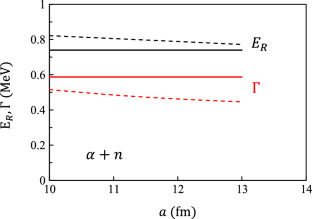Resonances in the R-Matrix Method
IF 1.7
4区 物理与天体物理
Q2 PHYSICS, MULTIDISCIPLINARY
引用次数: 0
Abstract
The R-matrix method is widely used in scattering calculations. We present a simple extension that provides the energy and width of resonances by computing eigenvalues of a complex symmetric matrix. We briefly present the method and show some typical applications in two- and three-body systems. In particular, we discuss in more detail the \(^6\)He and \(^6\)Be three-body nuclei (\(\alpha +n+n\) and \(\alpha +p+p\), respectively). We show that large bases are necessary to reach convergence of the bound-state or resonance properties.


R 矩阵法中的共振
R 矩阵法广泛应用于散射计算。我们介绍一种简单的扩展方法,它通过计算复对称矩阵的特征值来提供共振的能量和宽度。我们简要介绍了该方法,并展示了在二体和三体系统中的一些典型应用。特别是,我们更详细地讨论了\(^6\)He 和\(^6\)Be 三体核(分别为\(\alpha +n+n\) 和\(\alpha +p+p\) )。我们表明,要达到束缚态或共振特性的收敛,需要很大的基数。
本文章由计算机程序翻译,如有差异,请以英文原文为准。
求助全文
约1分钟内获得全文
求助全文
来源期刊

Few-Body Systems
物理-物理:综合
CiteScore
2.90
自引率
18.80%
发文量
64
审稿时长
6-12 weeks
期刊介绍:
The journal Few-Body Systems presents original research work – experimental, theoretical and computational – investigating the behavior of any classical or quantum system consisting of a small number of well-defined constituent structures. The focus is on the research methods, properties, and results characteristic of few-body systems. Examples of few-body systems range from few-quark states, light nuclear and hadronic systems; few-electron atomic systems and small molecules; and specific systems in condensed matter and surface physics (such as quantum dots and highly correlated trapped systems), up to and including large-scale celestial structures.
Systems for which an equivalent one-body description is available or can be designed, and large systems for which specific many-body methods are needed are outside the scope of the journal.
The journal is devoted to the publication of all aspects of few-body systems research and applications. While concentrating on few-body systems well-suited to rigorous solutions, the journal also encourages interdisciplinary contributions that foster common approaches and insights, introduce and benchmark the use of novel tools (e.g. machine learning) and develop relevant applications (e.g. few-body aspects in quantum technologies).
 求助内容:
求助内容: 应助结果提醒方式:
应助结果提醒方式:


